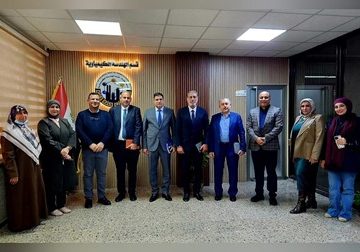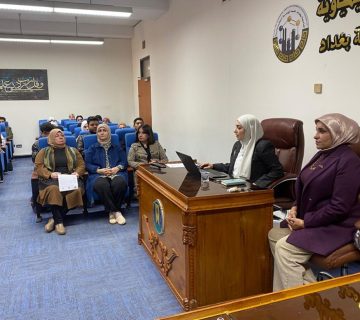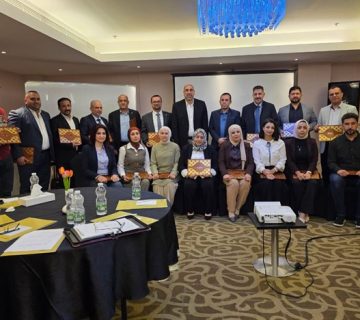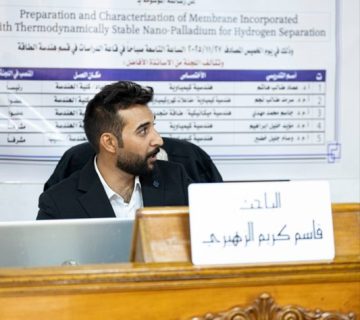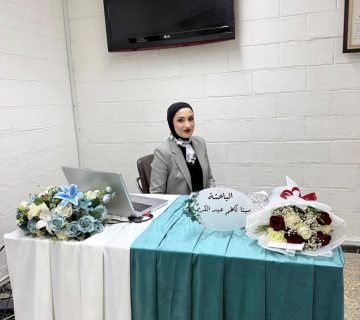The Chemical Engineering Department at the College of Engineering, University of Baghdad, held an MSc thesis examination titled:
“Performance of Prepared MOF 199 in Purification of Simulated of Wastewater from Methylene Blue Dye”
By the student Osama Jassim Attar and supervised by Assist. Prof. Dr. Rana Thabet Abd Alrubaye The examination committee consisted of Prof. Dr. Adnan A. Abdul Razak as Chairman and the membership of Assist. Prof. Dr. Asrar Al-Obaidy and Assist. Prof. Dr. Tariq M. Naife. After conducting the public discussion and listening to the student’s defense, the thesis was accepted. The thesis was summarized as follows:
The primary objective of this study is to develop a high-performance adsorbent for the purification of wastewater from Methylene blue (MB) dye.The MOF-199 was synthesized and utilized as an adsorbent to conduct a batch adsorption process to purify wastewater contaminated with organic dyes, specifically methylene blue. The wastewater used in this study will be an aqueous solution designed to simulate industrial wastewater.
MOF-199 was effectively synthesized using hydro/solvo thermal conditions. In order to obtain a highest surface area for adsorbent (MOF-199) two type of solvent were studied, including pure ethanol and varying ratio of ethanol to water. The properties of metal-organic framework MOF-199 have been characterized using several analytical techniques, including the utilization of the Brunauer-Emmett-Teller (BET) method for the investigation of surface area and pore volume, X-ray diffraction (XRD), Fourier-transform infrared spectroscopy (FTIR), scanning electron microscopy (SEM), and Energy-dispersive X-ray spectroscopy (EDX).The X-ray analysis of the synthesized MOF-199 (pure ethanol sample A) exhibited a high degree of crystallinity, reaching 100%, indicating the successful formation of the organic framework. Furthermore, a comparison between pure ethanol and other samples frameworks demonstrated a significant surface area difference of adsorbents. The surface area of the pure ethanol MOF-199 (Sample A) was determined to be 1119.469 m2/g, with the pore volume was measured to be 0.655 cm3/g, which suggested that this sample would be a qualified adsorbent.
Moreover, in this study explores the impacts of different parameters on removing Methylene Blue (MB) from aqueous solutions using MOF-199 Sample A was explored to identify the best conditions that yield the most effective removal of MB dye. The best conditions under investigation included; Acidic Function pH (ranging from 2 to 12), Contact Time t (ranging from 30 to 210 minutes), Adsorbent Dose (ranging from 0.5 to 3.5 g/L), Initial Concentration (ranging from 20 to 250 ppm), Agitation Speed set at 250 rpm, and Temperature T maintained at 25°C. The maximum percentage of methylene blue removal was 97.19%, with maximum an adsorption capacity of 75.757 mg/g. These best results were achieved at a pH of 7.5, a contact time of 90 minutes, an adsorbent dose of 0.2 g, and an initial concentration of methylene blue of 20 ppm.
In addition, an investigation the utilization of MOF-199 for the isothermal adsorption process to remove methylene blue (MB) was achieved using Freundlich, Temkin, and Langmuir models. The results of the isothermal adsorption of methylene blue were found to align with the Freundlich model, as indicated by a correlation coefficient (R2) of around 0.9989. The study also investigated the kinetic adsorption model of first and second order, revealing that the rate reaction followed a second-order. Pattern, this suggests that removing methylene blue dye from its aqueous solution using MOF-199 primarily occurs through chemisorption. Additionally, the process is shown to be endothermic, exhibiting unpredictability and occurring spontaneously. Finally, the MOF-199 material can have remarkable reusability as an adsorption material for MB by a process involving solvent washing, subsequent drying, and subsequent efficiency of MOF-199 exhibited a reduction of 14.43% after undergoing four cycles, compared to its initial state.




